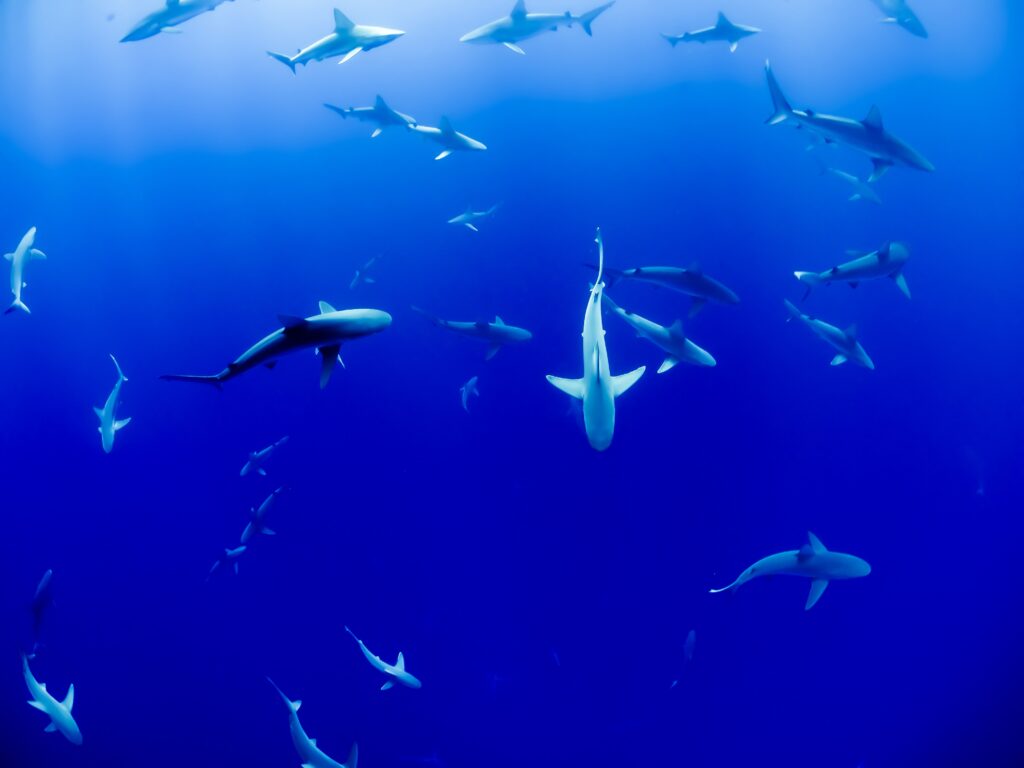Imagine you’re deep underwater, surrounded by the vast expanse of the ocean. The question arises: do scuba divers see sharks? The answer may surprise you. In this article, we uncover the truth behind this intriguing question and shed light on the thrilling encounters that await those who venture into the depths. Whether you’re an experienced diver or simply curious about the world beneath the waves, prepare to be captivated by the secrets that lie beneath the surface.

Factors That Influence Shark Sightings
Water Conditions
One of the primary factors that influence shark sightings is the water conditions. Clear and calm waters provide better visibility, increasing the chances of spotting a shark. On the other hand, murky or turbid waters may make it more difficult to see sharks, as their camouflage allows them to blend in with their surroundings. Additionally, the temperature and salinity of the water can affect shark behavior and movement patterns.
Location and Dive Site
The location and dive site also play a significant role in the likelihood of shark encounters. Certain areas, such as reefs or areas with abundant food sources, are more likely to attract sharks. Some dive sites are specifically known for their high shark populations, making them ideal for shark enthusiasts. It is important to research and choose dive sites that have a higher probability of shark sightings if that is an experience you are seeking.
Time of Day
The time of day can have an impact on shark sightings as well. Sharks, like many other marine creatures, exhibit different behaviors during different times of the day. For example, some species are more active during the early morning or late afternoon, while others may be more active at night. By diving during the appropriate time of day, you can increase your chances of encountering sharks in their natural habitat.
Season
The season can also influence shark sightings, as their migration patterns and feeding habits often vary throughout the year. Some species may be more common during certain seasons, while others may prefer different water temperatures or food sources. It is important to research and determine the best time of year to dive if you are specifically interested in encountering sharks.
Baiting and Feeding Practices
Baiting and feeding practices can significantly increase the likelihood of shark encounters. Many dive operators use chumming, which involves deploying a mixture of fish parts and oils into the water to attract sharks. This practice can be controversial as it alters the natural behavior of sharks and may create an artificial dependency on food sources provided by humans. However, it can also provide divers with the opportunity to observe sharks up close and learn more about their behavior.
Methods Used to Increase Shark Encounters
Chumming
Chumming is a commonly-used method to increase shark encounters during dives. As mentioned earlier, it involves deploying a mixture of fish parts and oils into the water to attract sharks. This method is particularly effective for attracting pelagic species, such as tiger sharks or great white sharks, that may not naturally inhabit the area. Chumming can provide divers with a thrilling experience, but it is important to ensure that it is practiced responsibly and with minimal impact on the ecosystem.
Shark Feedings
Shark feedings are another method used to increase shark encounters. Some dive operators offer dives where they actively feed the sharks, creating a controlled environment for divers to observe these magnificent creatures up close. While this may be an exhilarating experience, it is crucial to remember that it can alter the natural behavior of sharks and may negatively impact their feeding patterns and aggression towards humans. Care must be taken to ensure that these practices are regulated and conducted with the utmost respect for the sharks and their habitat.
Underwater Acoustics
Underwater acoustics, such as playing specific sounds or using hydrophones, can be utilized to attract sharks to specific dive sites. Some research has suggested that certain shark species may be attracted to particular frequencies or sounds that mimic natural prey. This method is still being explored and has the potential to provide divers with unique opportunities to interact with sharks in a non-invasive manner.
Diving at Shark Aggregation Sites
Diving at shark aggregation sites, also known as “cleaning stations,” can greatly increase the chances of encountering sharks. These sites are areas where sharks gather for cleaning and removal of parasites by smaller fish species. By positioning oneself near these cleaning stations, divers can observe various shark species as they interact with cleaning fish. It is important to note that these sites may have specific regulations and guidelines to ensure the safety of both the divers and the sharks.
Shark Species Commonly Encountered by Scuba Divers
Reef Sharks
Reef sharks, such as the Caribbean reef shark or the blacktip reef shark, are among the most commonly encountered shark species during scuba dives. They are typically found in tropical and subtropical waters near coral reefs, where they play a vital role in maintaining the ecosystem’s balance. Reef sharks are generally not aggressive towards humans unless provoked, and divers may have the opportunity to witness their graceful swimming and hunting behaviors.
Nurse Sharks
Nurse sharks are frequently encountered by scuba divers, particularly in the Caribbean and Central American waters. These docile sharks are often found resting on the ocean floor or in underwater caves during the day, becoming more active at night when they search for food. Nurse sharks are generally gentle and pose minimal threat to humans, allowing for up-close encounters and memorable diving experiences.
Hammerhead Sharks
Hammerhead sharks, with their distinctively shaped heads, are a sight to behold for many scuba divers. They are known to inhabit tropical and temperate waters worldwide, often seen near drop-offs, seamounts, and underwater structures. Hammerhead sharks are generally shy and not considered a significant threat to humans. However, caution should always be exercised when diving with any shark species, and a respectful distance should be maintained at all times.
Tiger Sharks
Tiger sharks are known for their large size and powerful presence. They can be found in both tropical and temperate waters, often near reefs, lagoons, and offshore areas. Tiger sharks are known to be opportunistic feeders, which can lead to encounters with divers attracted by the smell of potential food sources. While tiger sharks are capable of aggressive behavior, they usually exhibit indifference or curiosity towards divers. It is important to follow safety guidelines and maintain a safe distance when diving with tiger sharks.
Whale Sharks
Whale sharks are the largest fish species in the world and are a popular attraction for scuba divers seeking unique encounters. These gentle giants can be found in warm waters near coastlines, where they feed on plankton and small fish. Unlike most sharks, whale sharks are filter feeders and pose no significant threat to humans. Diving with whale sharks can be a truly awe-inspiring experience, allowing for close observation of their immense size and beauty.
Great White Sharks
Great white sharks, often depicted as the ultimate apex predator, are a species that both intrigues and captivates divers. While encounters with great whites are relatively rare, certain locations, such as South Africa or Australia, offer the opportunity to cage dive or observe these magnificent creatures from a safe distance. It is important to note that great white sharks are powerful predators and should be approached with the utmost caution and respect.
Safety Measures for Diving with Sharks
Maintaining Distance
When diving with sharks, it is crucial to maintain a safe distance to minimize the risk of incidents. Approaching sharks too closely or invading their personal space can lead to defensive or aggressive behavior. It is recommended to stay at least several meters away from sharks and avoid any sudden or aggressive movements that may startle them.
Respecting Shark Behavior
Respecting the natural behavior of sharks is essential for both the diver’s safety and the well-being of the sharks. It is important to remember that sharks are wild animals and should be treated with caution and respect. Observing from a distance and allowing the sharks to control the interaction ensures a more harmonious experience for both the diver and the shark.
Avoiding Sensationalism
While encounters with sharks can be thrilling, it is essential to avoid sensationalism and focus on responsible and respectful interactions. Sharks should never be provoked or provoked for the sake of an adrenaline rush or capturing an exciting photograph. Sensational and reckless behavior can potentially disturb or harm the sharks and their habitat.
Staying Calm and Relaxed
Maintaining a calm and relaxed demeanor is crucial when diving with sharks. Sharks are highly sensitive to changes in body language and can perceive fear or anxiety. It is important to control any panic or rapid movements, as these can trigger defensive or predatory behavior in sharks. By remaining calm, divers can ensure a more enjoyable and safe encounter with these magnificent creatures.

Typical Shark Behavior towards Scuba Divers
Curiosity and Investigative Behavior
Sharks are naturally curious creatures and may exhibit investigative behavior towards scuba divers. They may approach divers to get a closer look or investigate unfamiliar objects or activities. This behavior is most commonly observed with reef sharks, nurse sharks, and smaller shark species. While it can be fascinating to witness, it is crucial to maintain a safe distance and avoid any actions that may provoke the sharks.
Predatory Behavior
Predatory behavior, although rare, can occur when sharks mistake divers or their equipment for potential prey. This behavior is more commonly associated with larger shark species, such as tiger sharks or great white sharks. Understanding shark body language and staying informed about local shark behavior can help divers recognize potential signs of predation and take appropriate safety measures.
Defensive Behavior
Sharks may display defensive behavior if they feel threatened or perceive divers as a potential danger. Defensive behaviors can include rapid movements, arching of the back, or displaying teeth. It is important to respect the shark’s personal space and avoid actions that may trigger defensive behavior. Staying calm, maintaining distance, and slowly swimming away can help diffuse potentially dangerous situations.
Passive/Indifferent Behavior
Many shark species exhibit passive or indifferent behavior towards divers. They may swim by without showing much reaction or demonstrate little interest in their presence. This behavior is often observed with larger pelagic species, such as whale sharks or hammerhead sharks. Divers should still maintain respectful distances and avoid any actions that could disturb or provoke the sharks, even if they appear passive.
Tips for Increasing Shark Encounters while Diving
Researching Dive Operators
When planning a dive trip with the goal of encountering sharks, it is essential to research and select reputable dive operators. Look for operators with a strong commitment to environmental conservation and ethical practices. They should have knowledgeable guides who prioritize the safety of both divers and sharks. Reading reviews from other divers can also provide valuable information about the likelihood of shark encounters and the quality of the overall diving experience.
Choose Shark Hotspots
Certain locations around the world are renowned for their high shark populations and frequent shark sightings. These “shark hotspots” offer divers a greater chance of encountering sharks during their dives. Examples of popular shark hotspots include the Maldives, the Bahamas, South Africa, or Costa Rica. By choosing destinations known for their shark populations, divers can increase their chances of memorable encounters.
Dive During Peak Activity
Researching the peak activity periods of different shark species can greatly increase the chances of encountering them during dives. For example, certain species may be more active during specific times of the year or time of day. By planning dives during these peak activity periods, divers can maximize their opportunities for shark encounters. Local dive operators or dive guides can provide valuable insights into the best times to dive for specific shark species.
Learn Shark Body Language
Familiarizing oneself with shark body language can help divers interpret the behavior and intentions of sharks during encounters. Understanding signs of aggression, curiosity, or indifference can allow divers to react appropriately and maintain a safe distance. Educational resources, such as books or online courses, can provide valuable insights into shark behavior and body language.

The Role of Scuba Diving in Shark Conservation
Shark Tourism and Economic Value
Scuba diving plays a crucial role in shark conservation through shark tourism. Many coastal communities rely on shark tourism to support their economies, providing them with an incentive to protect and preserve shark populations and their habitats. By demonstrating the economic value of sharks through diving tourism, local communities and governments are encouraged to establish marine protected areas and implement sustainable practices to ensure the long-term survival of these apex predators.
Education and Public Awareness
Scuba diving offers a unique opportunity to educate divers and raise public awareness about the importance of shark conservation. By witnessing sharks in their natural habitat, divers gain a deeper understanding and appreciation for these incredible creatures. Dive operators and organizations often incorporate educational components into their dive experiences, sharing information about shark behavior, biology, and the threats they face. This increased awareness helps combat misconceptions and promotes the global conservation efforts needed to protect sharks.
Citizen Science and Research
Scuba divers can actively contribute to shark conservation through citizen science and research initiatives. Many organizations encourage divers to report their shark sightings and share their underwater photographs and videos. This data contributes to scientific research, allowing for a better understanding of shark populations, migration patterns, and behavior. By involving divers in these efforts, the global scientific community can gather more comprehensive data on sharks and develop effective conservation strategies.
Advocacy for Marine Protected Areas
Scuba divers are often at the forefront of advocating for the establishment of marine protected areas (MPAs) that prioritize the conservation of sharks and their habitats. Divers have witnessed firsthand the beauty and importance of these ecosystems and understand the need for their preservation. Through their passion for diving and shark encounters, divers can actively engage in conservation initiatives, lobbying governments and supporting organizations working towards the creation and expansion of MPAs.
Best Destinations for Shark Diving
Costa Rica
Costa Rica offers diverse opportunities for shark encounters, particularly along its Pacific coastline. Cocos Island, a UNESCO World Heritage Site, is famous for its hammerhead shark populations. The nutrient-rich waters attract a wide variety of shark species, including whale sharks, tiger sharks, and reef sharks. Additionally, the country’s southern Pacific coast is a known gathering site for migrating humpback whales, creating a unique diving experience.
South Africa
South Africa is renowned for its exceptional shark diving opportunities, particularly with great white sharks. The coastal town of Gansbaai, also known as the “Great White Shark Capital of the World,” is a popular destination for cage diving. Diving enthusiasts can observe these magnificent predators up close and learn more about their behavior and conservation status. South Africa also offers the chance to dive with other shark species, including tiger sharks, bronze whaler sharks, and ragged-tooth sharks.
The Bahamas
The Bahamas is a top choice for divers seeking encounters with various shark species. The crystal-clear waters surrounding the islands attract sharks year-round, including reef sharks, bull sharks, and Caribbean reef sharks. The island of Bimini is particularly famous for its great hammerhead shark sightings during the winter months. Additionally, the Bahamas offers the unique opportunity to dive with tiger sharks in a controlled environment, allowing divers to observe these powerful creatures from a safe distance.
Australia
Australia is a paradise for shark enthusiasts, offering numerous diving sites with a variety of shark species. The Great Barrier Reef, one of the world’s most famous dive destinations, is home to an abundance of reef sharks, including whitetip and blacktip reef sharks. The Ningaloo Reef in Western Australia is famous for its seasonal gatherings of whale sharks, giving divers the chance to swim alongside the largest fish in the ocean. South Australia also offers cage diving experiences with great white sharks, providing a thrilling adventure.
Maldives
The Maldives is renowned for its stunning coral reefs, vibrant marine life, and exceptional shark encounters. The underwater channels and cleaning stations attract various species, including reef sharks, nurse sharks, and hammerhead sharks. Divers can immerse themselves in the rich biodiversity of the Maldives and witness the elegance and power of these magnificent creatures. The country has also implemented strict regulations to protect its marine environment and ensure sustainable shark tourism.

Technologies and Equipment for Shark Encounters
Underwater Cameras
Underwater cameras are essential for capturing and preserving the memories of shark encounters. Divers can document their experiences and share them with others, promoting awareness and appreciation for sharks and their importance in the marine ecosystem. High-quality underwater cameras are designed to withstand the depth and pressure of scuba diving, allowing divers to capture stunning images and videos of sharks in their natural habitats.
Shark Shields
Shark shields, also known as shark deterrent devices, are electronic devices designed to create a protective barrier around divers and reduce the risk of shark attacks. These devices emit an electromagnetic field or a series of electrical pulses that interfere with the shark’s sensory receptors, deterring them from approaching. While the effectiveness of shark shields may vary, they provide an additional layer of protection and peace of mind for divers.
Shark Repellents
Shark repellents are chemical or physical substances designed to deter sharks from approaching divers. These repellents can take the form of specific scents, chemicals, or even physical barriers. However, it is important to note that the efficacy of shark repellents is still a subject of ongoing scientific research, and their use should be complemented with other safety measures and a respectful attitude towards sharks.
Dive Lights
Dive lights are an essential tool for scuba divers, particularly when diving with sharks. These lights enhance visibility in darker or deeper environments, allowing divers to spot sharks more easily. Additionally, dive lights can be used to attract marine organisms, which can indirectly lead to shark encounters as sharks may be drawn to areas with increased activity. By using dive lights responsibly and being mindful of potential environmental impacts, divers can enhance their overall shark diving experience.
Conclusion
Scuba diving provides an incredible opportunity to witness and appreciate sharks in their natural habitats. Factors such as water conditions, location, time of day, and season influence the likelihood of shark encounters. Various methods, including chumming and underwater acoustics, can be used to increase shark encounters for divers seeking these experiences. It is important for divers to maintain a respectful distance, understand shark behavior, and avoid sensationalism or reckless behavior. By following safety measures and being informed, divers can enjoy memorable and enriching encounters with these majestic creatures. Scuba diving also plays a vital role in shark conservation through shark tourism, education, research, and advocacy efforts. With the right destinations, equipment, and knowledge, divers can embark on thrilling shark diving adventures while promoting the protection of these apex predators and their ecosystems.

- Can You Dive With Sharks In California? - August 19, 2023
- What Are The Rules Of Shark Cage Diving? - August 19, 2023
- Where In Florida Can You Dive With Sharks? - August 19, 2023








